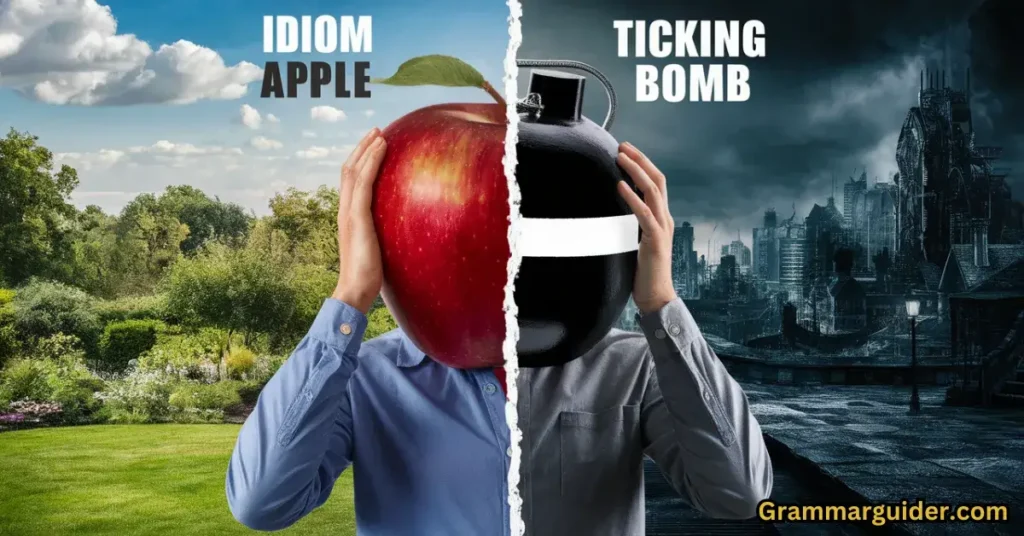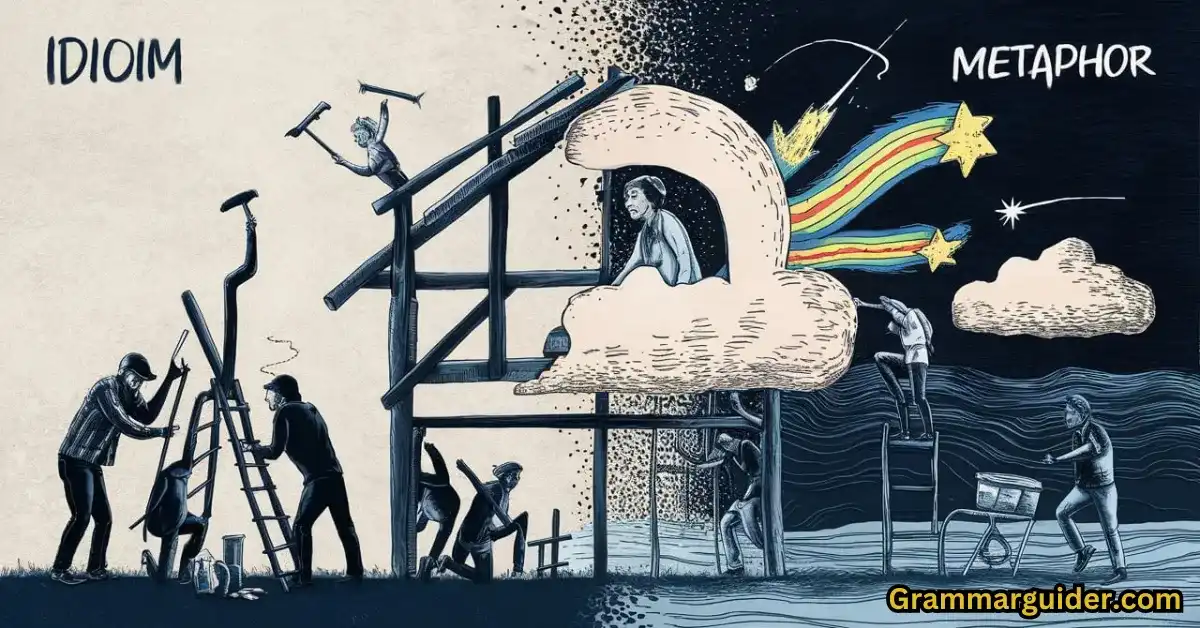When we engage in everyday communication, we often use expressions that don’t necessarily mean what they seem to at first glance.Idiom vs metaphor are two types of figurative language that add richness to the way we express ourselves. While they may seem similar at times, understanding the difference between idiom and metaphor can enhance how we use language effectively.
In this article, we’ll explore the key distinctions between metaphor vs idiom, give real-life examples, and explain how to use both in different scenarios.
What Is a Metaphor?
A metaphor is a figure of speech where one thing is described as if it were something else. This comparison is meant to highlight a shared characteristic between the two objects, often to create a vivid image in the mind of the listener or reader.
For example, if someone says, “Time is a thief,” they don’t mean that time is literally a criminal, but rather, they are implying that time takes away moments from our lives, much like a thief might steal possessions.
Metaphors are commonly used in literature, poetry, and everyday conversation to help express abstract ideas in a more tangible way. They can make your writing or speech more compelling and poetic.
Example Scenario: A Business Email
Let’s consider an example of how a metaphor could be used in a professional email.
Subject: Upcoming Project Timeline
Dear Sarah,
I wanted to touch base regarding the upcoming project. We’re moving quickly, and while we’ve made good progress, it feels like we’re racing against the clock. The deadline is approaching, and we need to ensure we stay on track to meet the target.
Let’s discuss our next steps when you have a chance.
Best regards,
James
In this example, “racing against the clock” is a metaphor. It does not literally mean the project is running alongside a clock, but it conveys the idea that time is running out, and there’s urgency to complete the project.

What Is an Idiom?
An idiom is a group of words or a phrase that has a meaning not deducible from the individual words. The meaning of an idiom is generally understood by native speakers or those familiar with the culture and language. These expressions are often rooted in history, culture, and tradition, and they can be quite colorful.
For example, if someone says, “It’s a piece of cake,” they are not referring to a literal cake, but instead, they mean that something is very easy.
Idioms are often culturally specific, meaning that the same idiom might not make sense in another language or culture. However, their figurative meanings are commonly understood within the context of the language they originate from.
Example Scenario: Casual Conversation
Here’s how an idiom might come up in a casual conversation:
Subject: Project Update
Hey John,
Just wanted to check in with you on the new product launch. I know you’ve been working hard on it, and I think we’re finally seeing the light at the end of the tunnel. Once we finalize these details, everything will be smooth sailing.
Catch you later,
Rachel
In this email, “seeing the light at the end of the tunnel” and “smooth sailing” are idioms. They don’t literally mean there’s light or sailing involved; instead, they imply that the project is almost finished and that things will be easier going forward.
The Difference Between Idioms and Metaphors
While metaphors vs idioms can often be confused, there are key differences between the two.
1. Meaning:
- Metaphors are comparisons that equate one thing with another to highlight a shared characteristic. For example, “He’s a lion in battle,” compares a person’s bravery to a lion.
- Idioms, on the other hand, have meanings that can’t be understood just by looking at the words in the phrase. The meaning is culturally or contextually learned, such as “kick the bucket” meaning to die, not actually kicking a bucket.
2. Structure:
- Metaphors are typically one sentence or phrase that compares two things. For instance, “The world is a stage” (from Shakespeare) compares life to a theatrical performance.
- Idioms can be longer expressions and are often a bit more complex. For example, “Bite the bullet” means to endure a painful situation, not literally biting a bullet.
3. Flexibility:
- Metaphors can be adapted and altered to fit different situations. You can say, “The world is a stage,” or, “The world is a jungle” to convey a similar idea with different imagery.
- Idioms are generally fixed phrases and cannot be easily modified. For example, you wouldn’t change “kick the bucket” to “kick the can” to mean the same thing.

Metaphor vs Idiom:
Which to Use When?
Choosing whether to use a metaphor or idiom depends on the situation, tone, and context of your communication. Here’s a quick breakdown:
- Use metaphors when you want to create vivid, imaginative comparisons that help explain or emphasize a point. They’re especially useful in storytelling, poetry, or speeches.
- Use idioms when you want to convey a concept in a colloquial, familiar way. They can make your language sound more natural and relatable, especially in casual conversations.
Scenario Comparison: Idioms vs Metaphors in Business Communication
Now, let’s compare how idioms vs metaphor could both be used in a business setting.
Subject: Budget Update
Dear Laura,
I wanted to provide an update on the budget for this quarter. As we discussed last week, it seems like we’re stuck between a rock and a hard place with these funding cuts. However, if we pivot and focus on these key areas, I believe we’ll find a way to keep moving forward.
Best,
Tom
In this email, “stuck between a rock and a hard place” is an idiom that conveys the feeling of being in a difficult situation with no easy way out. On the other hand, “keep moving forward” is more of a metaphor, implying that progress will continue despite obstacles.
Key Differences at a Glance
To help clarify, here’s a comparison table outlining the key difference between metaphor and idiom:
| Feature | Metaphor | Idiom |
|---|---|---|
| Definition | A direct comparison between two unlike things. | A phrase with a meaning not deducible from its words. |
| Meaning | Implies a shared characteristic or concept. | Has a figurative meaning, understood by context. |
| Examples | “Time is a thief” | “Break a leg” (meaning good luck) |
| Flexibility | Flexible and can be altered to fit different contexts. | Fixed and cannot easily be altered. |
| Use | Often used in literature, poetry, and speeches. | Common in everyday speech and informal contexts. |
Understanding the Power of Figurative Language
Both idioms vs metaphor serve important roles in communication, and knowing when to use each can enhance your ability to connect with others. Metaphors help convey complex ideas in a concise, creative way, while idioms offer a shorthand for expressing familiar experiences or emotions.
By mastering both, you’ll be able to communicate with greater precision and impact.
Using Metaphors and Idioms Together
You don’t always have to choose between a metaphor and an idiom; sometimes, you can combine both in a single conversation or piece of writing. For example, imagine you’re giving a presentation about overcoming obstacles in business. You could say:
“Running a startup is like navigating a ship through a storm. We’ve faced many challenges, but I believe we’re starting to see the light at the end of the tunnel.”
In this sentence, “navigating a ship through a storm” is a metaphor that illustrates the difficulty of running a startup. “Seeing the light at the end of the tunnel” is an idiom that expresses hope after a period of hardship.
Conclusion
While metaphor vs idiom might seem like a fine line, each of these figures of speech serves its own unique purpose in language. Metaphors offer vivid comparisons, while idioms provide familiar, culturally-specific expressions that convey meaning quickly and effectively.
Understanding the difference between idiom and metaphor allows you to use each tool in the most appropriate way, depending on the tone, context, and message you wish to convey.

Harley Rose is a seasoned expert in English grammar and writing tips, blending years of knowledge and a love for language into her work. With a sharp eye for detail and a talent for making grammar accessible, Harley shares practical insights that help readers write with precision and flair. Her content is ideal for anyone looking to strengthen their writing skills and express themselves with confidence.

